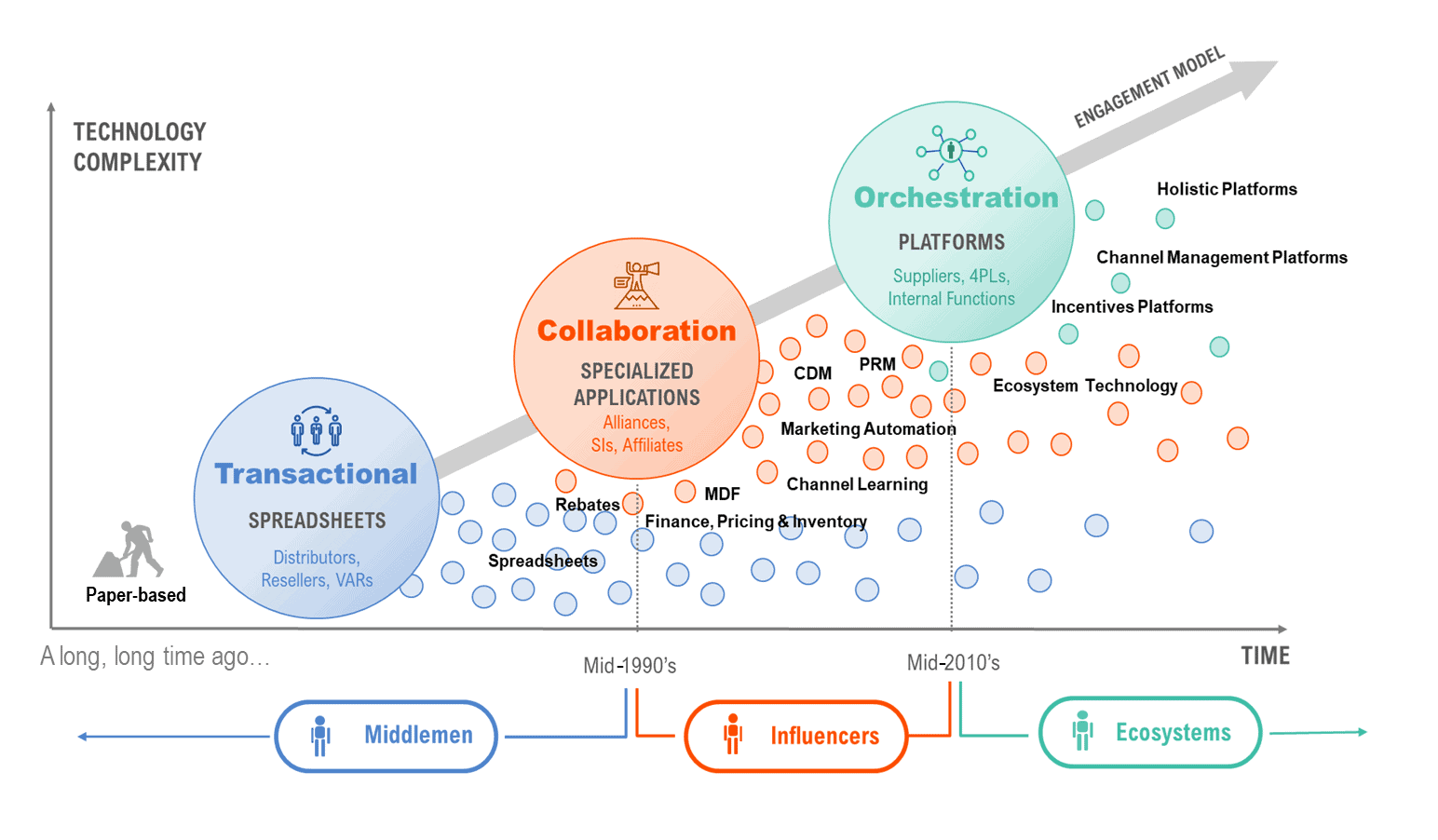
Understanding channel partner engagement
Throughout history, channels have evolved in terms of composition, relationships, and partner engagement models. What started as transactional, arms-length engagement with traditional “middleman” partners became collaborative relationships with influencing parties. More recently, channel management has emerged as ecosystem orchestration. (For more details about the ecosystem model, download the whitepaper Adapting Channels to the New Ecosystem Economy). Each of these channel models have different technology requirements, and misalignment leads to friction. Channel friction leads to partner dissatisfaction and loss of loyalty, which diminishes the brand’s market share and mindshare and reduces revenues and returns on investment.
To mitigate channel friction, it’s vital to understand which technology is right for each engagement model and how these technologies have worked throughout history.
The evolving role of channel partner technology
The age of middlemen
Throughout most of channel history, the supporting technology was pen and paper (or dye and hide, ink and papyrus, clay tablets, and the like). The end of the 20th century saw massive growth in the number of partners and increasing complexity of channel programs, and the expansion of the channel led to hyper-growth in the volume of data processed (for details, see the blog post The Ages of Channels). That data explosion meant pen and paper were no longer enough. Brand owners increasingly started to use spreadsheets to run their channels.
By the mid-1990s, brand owners began to discover that, though spreadsheets can house massive quantities of data, they are still essentially just an electronic form of pen and paper. The processes were still manual and inaccurate, requiring too much time and too many resources. Specialized software applications such as channel incentives management and channel finance, pricing, and inventory solutions emerged to support transactional engagement with partners and mitigate these challenges. These specialized applications brought automation and process simplification, and some even included artificial intelligence (AI) to improve partner engagement and resource utilization. The initial adoption of channel applications remained low, and according to an analyst survey, 30% of respondents still use spreadsheets to manage incentives for their partners even today.
The age of the influencers
By the end of the 1990s, progress in AI and the accelerated spread of e-commerce changed the buying journey for consumers and businesses alike. It led to a rise in influencer partners and transformed the engagement model from transactional to collaborative. Brand owners began to rely on influencers—no longer just middlemen—to promote their products and educate buyers. From a technology perspective, this triggered the uptake of additional software categories. It stimulated the growth of applications that encouraged and supported collaboration and shared knowledge, content, and leads. Examples include channel learning and readiness, partner relationship management, and through-channel marketing automation applications.
The age of the ecosystems
In the last five years, some companies have begun to look at their indirect channels not as merely a collection of distributors and resellers but as part of an ecosystem, and they have sought to manage the channels holistically by orchestrating that ecosystem. However, channel orchestration requires each part of the ecosystem to be connected end-to-end. This can’t happen when companies still utilize spreadsheets and disconnected, specialized applications as the main technologies to support their channel business processes.
Challenges in Channel Partner Engagement
To achieve connectivity, disparate solutions must be integrated. Different applications with different data models, different vendors, different partners for each step of a buyer’s journey, and different development time frames will make integration a challenge. Unfortunately, integration has always been a costly and time-consuming endeavor. To complicate matters further, with rare exceptions, processes, and the user experience often remain disjointed even after integration. The recognition of these facts led to the emergence of orchestration platforms, and more recently, the channel technology market has started to consolidate, with several vendors seeking to build platforms. In fact, analysts estimate that the pace of mergers and acquisitions (M&A) will continue to accelerate, evolving the industry from hundreds of point solutions to a series of vertical and horizontal orchestration platforms.
Vertical platforms address some of the integration needs but are still functionally focused. A good example is incentive management platforms, which bring rebates, rewards, development funds, loyalty points, and other types of incentives under one roof. Historically, these were distinct applications and targeted different channel audiences. Horizontal platforms provide capabilities to support diverse functional needs. They deliver a unified user experience for all and eliminate the need to spend time and effort integrating disparate solutions. Horizontal platforms are not all equal, though. Some concentrate on supporting all traditional channel processes across all traditional channel partners—these are channel management platforms. Others expand beyond tradition to reach and orchestrate the entire ecosystem. Orchestration platforms give businesses the flexibility to respond faster to changes in the business environment and adapt and transform their operating model to increase resilience, competitive differentiation, revenue growth, and cost optimization. Horizontal orchestration platforms can support any partner engagement model.
Aligning technology with partner engagement
The diagram below summarizes the technology evolution over time and shows how it relates to the various partner engagement models.

Today all engagement models are still in use, and so are the supporting technologies but companies must evaluate their business environment and assess whether their existing partner engagement model meets their current and future needs. Depending on the result, they may need to consider additional ways to interact with partners or evolve to new models. Once the right engagement model is determined, companies should adapt the technology accordingly to prevent friction.
To find out more about the technology stack for orchestration, download the whitepaper Enabling Holistic Channel Management: A Technology Guide.







